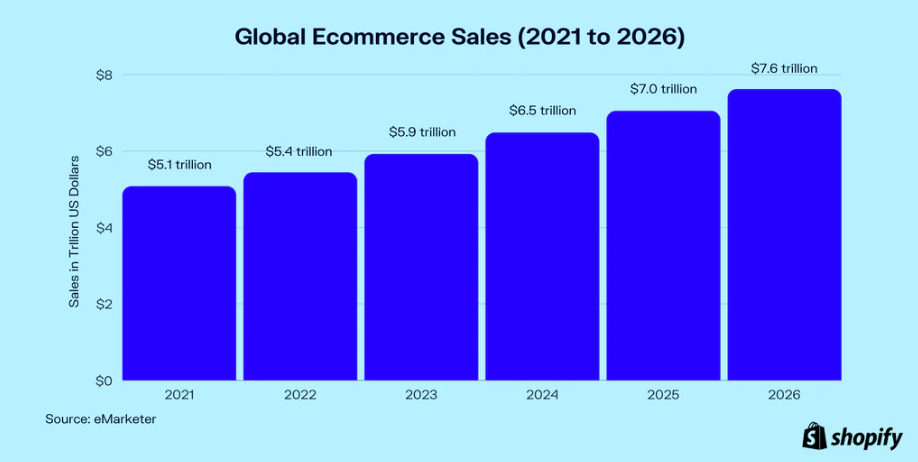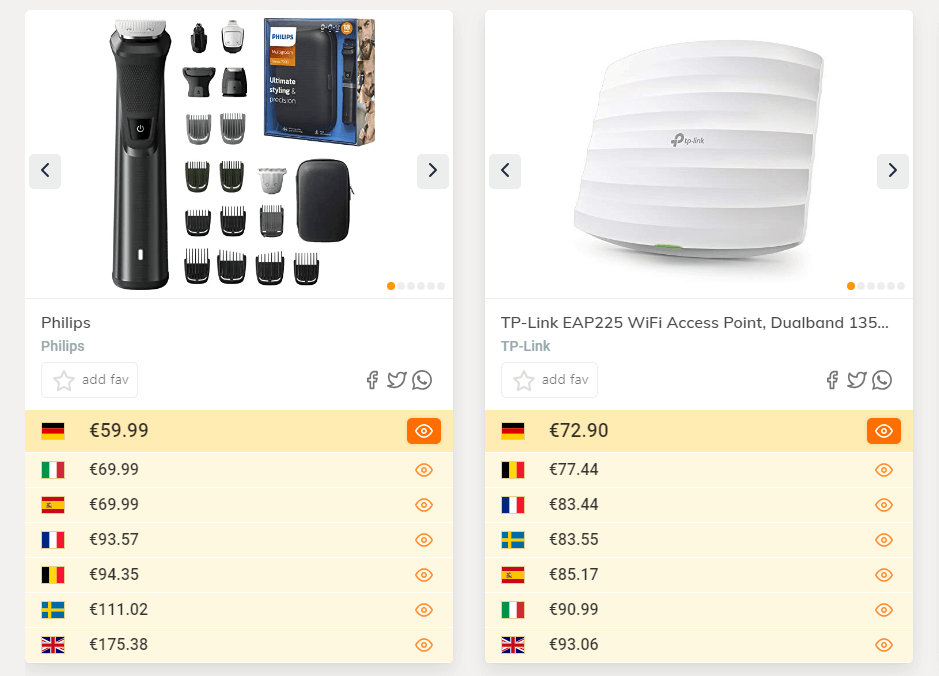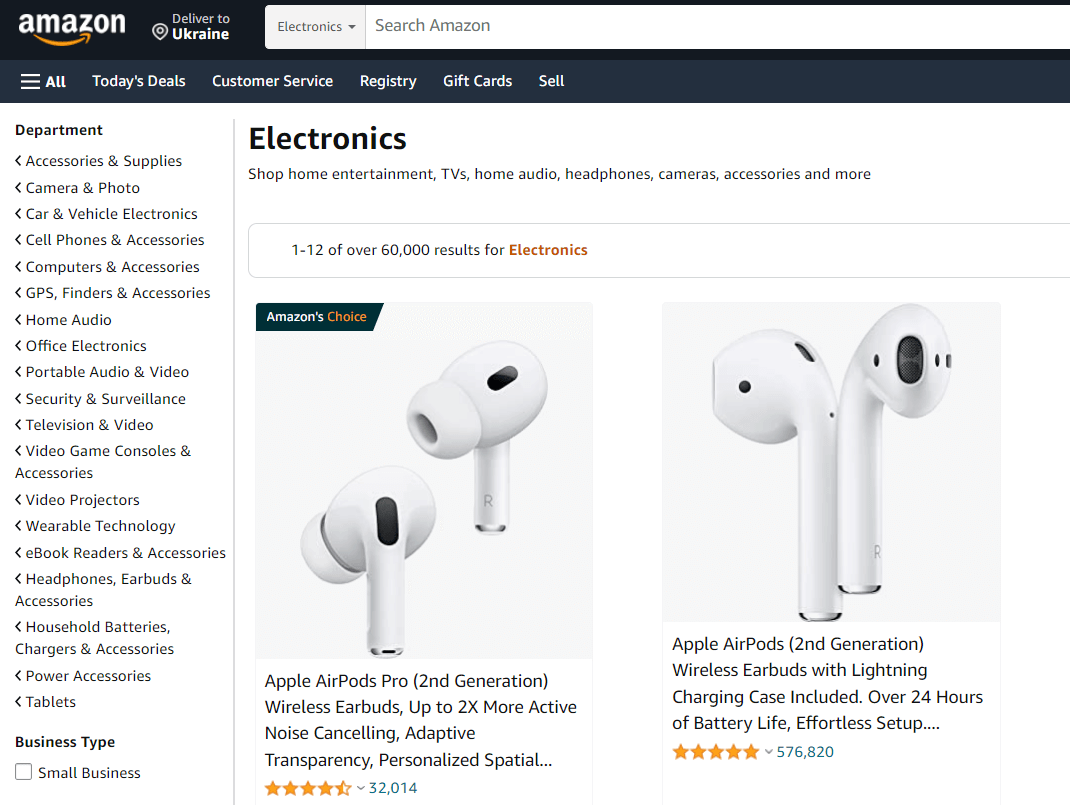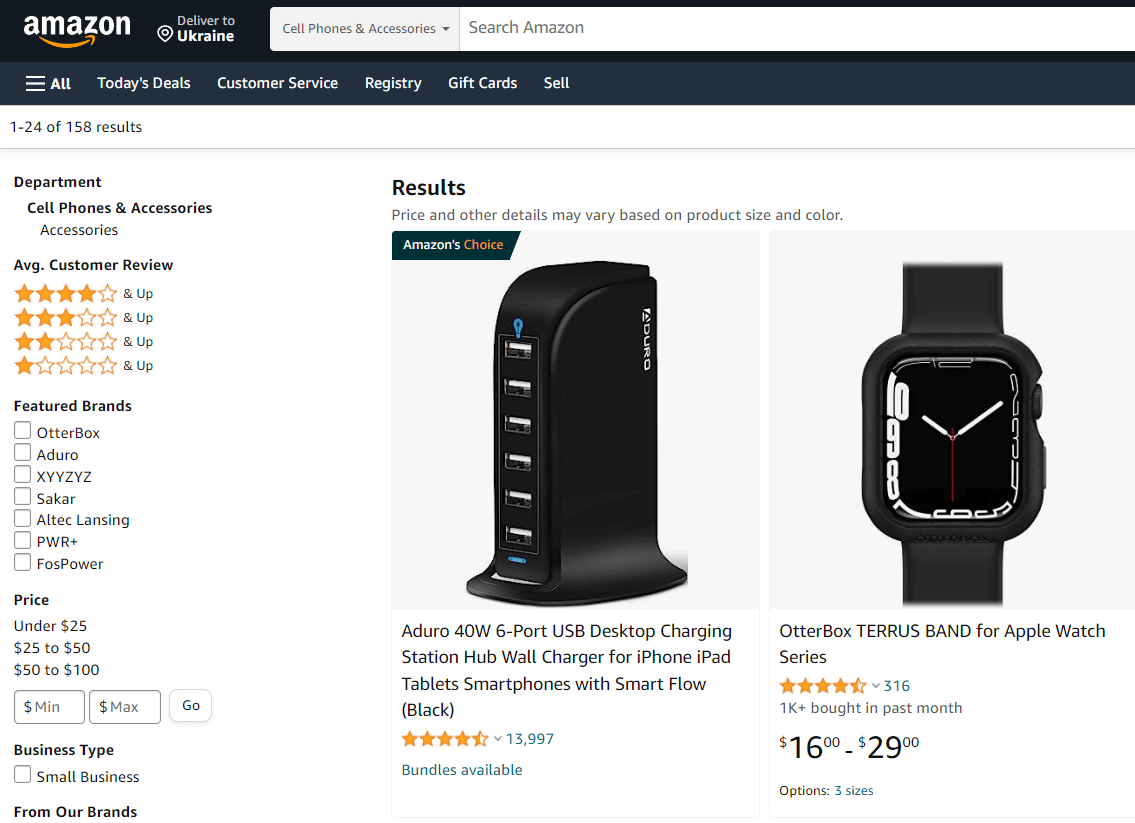In 2022, the sales volume of the global e-commerce market reached $5.5 trillion. The top 100 marketplaces made up 63% of online sales. There are lots of places where online sales happen. These places can be generally divided into comparison sites, marketplaces, and affiliate networks.
Even when people shop offline, 65% check products on price comparison sites. Affiliate marketing has been growing and was valued at $12 billion in 2022. According to eMarketer, in 2023, worldwide e-commerce sales will reach $5.9 trillion. This trend will persist, offering businesses an opportunity to drive growth. The chart below illustrates the tendency.

Affiliate networks allow affiliates to promote and raise awareness for products or services. Affiliate networks are online platforms earning a commission from sales or leads made.
Consumers filter and compare prices/goods from different providers on a comparison site. Price comparison websites help merchants willing to stay competitive in the market. Such comparison sites allow sellers to analyze competitors and improve their businesses.
The marketplaces are the platforms where various stores display their products. By joining such websites, sellers can expand their audiences and their visibility. The marketplaces ease the exchange of goods between two parties.
All three platforms offer marketing tools, features, and services to promote products. It can be banners, social media campaigns, personal assistants, or analytics insights. Comparison sites, marketplace, and affiliate networks serve as extra channels for business growth. All three serve the same purpose—improve your sales. But they work in completely different ways.
What you need to know about comparison sites
The global comparison websites market estimation was $2.8 billion in 2019. It is going to reach 8% by 2028. Retail products are the market's largest segment, accounting for 30% of revenue share. Asia Pacific, for instance, witnesses significant growth of 9%. It happens due to a high penetration rate and growing smartphone usage.
A comparison site is a website comparing the prices of products/services of stores. Retailers list their products on comparison websites to attract more customers. It helps build a strong online presence and reach more prospective buyers.
Retailer businesses can sell different categories, thus expanding their business horizons. Moreover, they can set prices for each product. Merchants can run promotions related to the price of individual or combined purchases.
How it works
When users visit a comparison website, the site gathers information about their preferences. This info helps to provide customized results. The comparison site returns a list of products that match the user's requirements. The site sorts them by price, key features, or popularity. All the options are together on one web page. The user can compare them on the screen and choose the best deal.
The algorithms governing the price comparison functions use data as input. Extracting and updating this data in real-time is challenging for price comparison engines. E-commerce sites use dynamic pricing, which may often change. They need to provide updates with the price comparison engines immediately. For example, Amazon takes exactly two minutes to adapt to a price change. That's 43000 minutes faster than the industry average.
PriceGrabber, Shopping.com, and Shopzilla offer an easy and fast way to locate the best prices. Shopzilla Inc. manages various international online platforms, including Bizrate, Best, PrixMoinsCher, and SparDeinGeld. To ease the connection with such platforms, you can use our application. The Mulwi app provides PrixMoinsCher, Spardeingold, and Google Shopping Shopify Feeds. These templates already meet all the needed specifications to save you time.
Being the largest search engine, Google is the ideal platform to show off products to buyers. According to a Think With Google survey, 55 percent of people search for products to buy on Google. Sellers can submit product data to the Merchant Center for inclusion in free listings. Free listings allow customers to see product results from your store across Google.
Google Smart Shopping ads appear in front of potential and existing customers. The Google Smart Shopping service automates bids and ad placements using machine learning. It determines the best time and place to show ads to your potential and existing customers.

Most comparison sites use three main methods of gathering information:
Direct feeds from merchants. Businesses allow price comparison providers to use their product feeds. It ensures the highest levels of price accuracy. It creates a good partnership between the site and the business in question.
Third-party APIs – another way comparison sites gather data is to use third-party APIs. These third parties scan retail sites to create a database of up-to-date prices.
Scraping or crawling – some comparison sites use automated bots to crawl provider websites. The bots will gather pricing data and send it back to the comparison servers for processing.
For buyers, using a price comparison site offers many benefits. First, it saves valuable time by scanning through thousands of deals in minutes. Comparison sites cut the need for manual searches. These sites are completely free to use, without any brokerage fees involved. They provide a clear and intuitive interface to ensure easy navigation.
Buyers gain access to a vast range of providers and deals. That may not be accessible through individual searches. Some price comparison sites go the extra mile by offering product reviews. It enables buyers to make informed purchasing decisions. Last, these platforms often provide bundled savings. It allows them to combine various services from different providers while saving money.
Sellers can benefit in several ways by utilizing a price comparison site. First, these platforms offer increased visibility, exposing products to a wider audience. By listing products alongside competitors, merchants gain valuable insights into their pricing strategies. It allows them to make informed adjustments to remain competitive in the market.
Price comparison sites also provide access to a targeted audience. Such websites increase the chances of converting visitors into customers. Utilizing a price comparison site can be a cost-effective approach. It leverages the platform's existing user base and marketing tools. Comparison sites help build brand reputation and credibility, instilling trust in potential customers. Leveraging a price comparison site can expand sellers' reach and boost sales. Such channels can provide valuable data for optimizing their pricing strategy.
What are affiliate networks
Many brands use affiliate marketing to differentiate their content and drive revenue. This tendency has become so popular that spending in the United States alone has reached $8.2 billion. It is up from $5.4 billion in 2017.
Affiliate marketing is an advertising model. A company compensates a third party for the promotion of goods. The third party generates traffic or leads to sell products/services. These third-party publishers are affiliates. They earn a fixed commission when a sale or another qualified action occurs. The idea is a revenue-sharing business model. It can lead to many companies forming what’s known as affiliate networks.
An affiliate network is an intermediary between affiliates and merchants. So they can find each other easier. It can also be a group of affiliated companies offering products or services. An affiliate network helps businesses open up new sales channels. It builds a database of potential leads. Yet, they may sometimes operate in different industries.
Three parties participate: the seller, the affiliate, and the customer. The seller could be a corporate enterprise like Reebok. It can be a smaller business or an entrepreneur. Merchants create products like consumer goods, digital products, and services. Then, they list them through an affiliate network. The affiliate is sometimes called the “publisher”. Affiliates promote products and engage potential customers. The customer is the most important person in the relationship. When they buy a product/service through an affiliate, the seller and the affiliate score a profit.
Affiliates have a large target market they cater to. They receive one-time or recurring commissions for every sale. Among the most popular are CJ Affiliate, Awin, and ShareASale. For instance, Awin’s affiliate platform is easy-to-use. It operates across 15 markets with over 241,000 active publishers. You'll get a specialist account team when you create an affiliate program with Awin. The team of specialists provides you with all you need to succeed in affiliate marketing. Awin offers coupon codes, email marketing, and display advertising to promote goods.
AWIN is one of the best affiliate networks, operating in over 180 countries with 16,500+ advertisers. The network has got more than 200,000 publishers. They were also voted the best cost-per-sale network in the United States. The service is an excellent choice for beginners. It offers a variety of business verticals like fashion and technology. The commission rate is about five percent. Affiliates have the option to register with a $5 initial payment. This deposit can be refunded once the first payment threshold is reached. Additionally, the brand owns another well-known affiliate platform called ShareASale.

How to use affiliate networks
Affiliate networks are easy to use, especially for those with affiliate marketing software. Users sign up for the network, then receive access to various products on the market. Certain networks have stringent criteria that affiliates must meet to join. Affiliate marketing involves sharing product marketing and content creation among many parties. It utilizes different talents to create a more effective strategy. Such marketing provides all contributors with a share of the profit. For some people, it’s passive income; marketers make a full-time living in other cases.
Affiliate marketing brings great rewards to the advertising company and the affiliate marketer. The business wins from low-cost advertising and creative marketing efforts — the affiliate benefits from earning generous commissions. The best affiliate programs have a big return on investment. The company only pays for traffic converted to sales. The affiliate alone bears the cost of advertising. The payment is usually based on performance.
To connect your store to Awin, you need to generate a product feed and submit it to the platform. Manual feed generation can take hours. The Mulwi app offers you the Awin Shopify Feed template in a minute. This template already comprises all requirements and specifications. Still, you can customize it to your preferences and needs.
What do you need to know about marketplaces
According to Lengow, over 60% of sales happen through marketplaces. Rakuten, Amazon, and eBay operate under this model. A marketplace platform allows merchants to display their products to many customers.
The marketplace owner's role is to connect vendors and customers, facilitating sales. Sellers can showcase and sell their products while the marketplace owner gets a commission from each successful sale. An online store, for comparison, is a single store selling its products online. The company that owns the website and products manages all marketing and operations.
Marketplace owners do not own the goods their platform sells. They leave the more operational side of the business to vendors. The marketplaces focus on promoting brands. They drive traffic to the platform and convert site views into sales.
Amazon is among the top marketplaces, there's no doubt about it. It has a huge number of regular customers, and the platform has about 100 million Prime users. Selling on Amazon equals a great chance of reaching its users. Yet, the marketplace is also a harsh environment. The products should have competitive prices to attract customers.

eBay and Amazon are often compared when discussing online selling platforms. eBay has been in the market since 1995, and you can find almost anything on the website. With eBay, you can tap into the global customer base of 168 million active buyers.
Rakuten comes from Japan, and its visits also come in a remarkable number – 799 million monthly. Its average monthly visit number is only behind that of Amazon and eBay. Like the other previous platforms, the products on Rakuten are very diverse. The categories range from clothing, books, and sports to drugstore and travel.
Selling on Rakuten can be easier by using a product feed with full data on your products. Sellers can generate a viable product feed that meets all the marketplace requirements. You can find the Rakuten Shopify feed template in the Mulwi app.
How do marketplaces operate
In an online marketplace, items are not sold by the marketplace operator. Instead, the items placed will come from third-party sellers. The marketplace's responsible for managing the site's aesthetics and customer experience. A customer makes a buy from a third-party seller through the marketplace.
The seller fulfills the order and ships the item to the customer. In exchange for the offering, the seller gets a new channel for growth. The operator earns a commission on each sale. As a marketplace operator, you can offer more products. No need to secure storage facilities or take on the extra associated risks of shipping the items. Also, buyers can access a wider range of products at more affordable prices. As you can see, the online marketplace benefits all parties.
Amazon Marketplace allows third-party sellers to market their products alongside their own. Amazon partners with more than 1.9 million sellers. Marketplace sales comprise 58% of the company's total sales figures.

Summary
Comparison sites, affiliate networks, and marketplaces offer valuable insights to businesses, marketers, and consumers. Each platform has advantages and considerations to weigh. The choice depends on various factors. They are ease of use, earning potential, reach, reputation, cost, and flexibility. Determining the most beneficial platform varies based on specific needs and circumstances.
Comparison shopping engines play a significant role in the modern digital landscape. These platforms provide buyers convenience, time-saving, and access to various options. Sellers can achieve increased visibility, competitive insights, and access to a targeted audience. Utilizing a price comparison site can be a cost-effective marketing strategy.
By partnering with affiliates, businesses can tap into their diverse target markets. They can leverage their promotional efforts, increasing sales and brand exposure. Affiliate networks serve as intermediaries, connecting affiliates and merchants and facilitating collaboration. They offer a platform for affiliates to access various products and services to promote. Merchants can expand sales channels and a pool of potential leads.
The marketplace model benefits all parties involved. It enables sellers to reach a broader audience. Buyers can gain access to a wider selection of products. Marketplace operators can generate revenue through commissions. As marketplaces continue to evolve and grow, they expand their reach.
All three shopping channels are distinct in their nature and functionality. Yet, they all share the goal of assisting sellers in expanding their businesses. These platforms can increase sellers' visibility and optimize their marketing strategies. Sellers can achieve their growth objectives via the diverse offerings these platforms provide.
Shopify stores can connect to the world's major shopping channels via the Mulwi app. The application allows users to export data from their stores using XML, CSV, and TXT feeds. The Mulwi app aims to save you time and effort starting the cooperation with a new channel. The application provides many features to ease the connection process. Grow business by expanding your sales channels with always up-to-date product feed.




